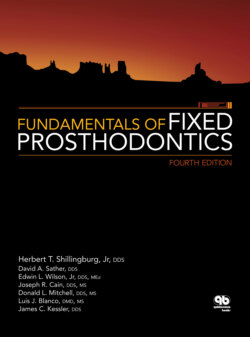Читать книгу Fundamentals of Fixed Prosthodontics - James C. Kessler - Страница 42
На сайте Литреса книга снята с продажи.
Anterior guidance
ОглавлениеDuring protrusive movement of the mandible, the incisal edges of mandibular anterior teeth move forward and downward along the palatal concavities of the maxillary anterior teeth. The track of the incisal edges from maximal intercuspation to edge-to-edge occlusion is termed the protrusive incisal path. The angle formed by the protrusive incisal path and the horizontal reference plane is the protrusive incisal path inclination, which ranges from 50 to 70 degrees.55,56 Although they are conventionally regarded as independent factors, there is evidence to suggest that condylar inclination and anterior guidance are linked, or dependent factors57,58 (Takayama H and Hobo S, unpublished data, 1989). In a healthy occlusion, the anterior guidance is approximately 5 to 10 degrees steeper than the condylar path in the sagittal plane. Therefore, when the mandible moves protrusively, the anterior teeth guide the mandible downward to create disocclusion, or separation, between the maxillary and mandibular posterior teeth. The same phenomenon should occur during lateral mandibular excursions.
Fig 2-19 (a) A pronounced vertical overlap of the anterior teeth permits posterior teeth to have longer cusps. (b) A minimum anterior vertical overlap requires shorter cusps.
Fig 2-20 (a) A pronounced horizontal overlap of the anterior teeth requires short cusps on the posterior teeth. (b) A minimum anterior horizontal overlap permits the posterior cusps to be longer
The palatal surface of a maxillary anterior tooth has both a concave aspect and a convexity, or cingulum. The mandibular incisal edges should contact the maxillary palatal surfaces at the transition from the concavity to the convexity in the centric relation position. The concavity represents a uniform shape in all subjects.59
Anterior guidance, which is linked to the combination of vertical and horizontal overlap of the anterior teeth, can affect occlusal surface morphology of the posterior teeth. The greater the vertical overlap of the anterior teeth, the longer the posterior cusp height may be. When the vertical overlap is less, the posterior cusp height must be shorter (Fig 2-19). The greater the horizontal overlap of the anterior teeth, the shorter the cusp height must be. With a decreased horizontal overlap, the posterior cusp height may be longer (Fig 2-20).
Fig 2-21 While a shallow protrusive path would require short cusps in the presence of minimal anterior guidance (a), the posterior cusps can be lengthened if the anterior guidance is increased (b).
Fig 2-22 (a) A pronounced immediate lateral translation would dictate short cusps where there is little anterior guidance. (b) However, the cusps can be lengthened if the anterior guidance is increased.
By increasing anterior guidance to compensate for inadequate condylar guidance, it is possible to increase the cusp height. If the protrusive condylar inclination is shallow, requiring short posterior cusps, the cusps may be lengthened by making the anterior guidance steeper (Fig 2-21). In like manner, increasing anterior guidance will permit the lengthening of cusps that would otherwise have to be shorter in the presence of a pronounced immediate lateral translation (Fig 2-22).
